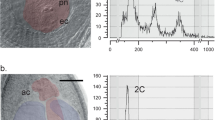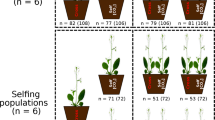Abstract
THE ecological consequences of albinism in plants have not been investigated, although the phenomenon has been considered by physiologists, geneticists and cytologists1–7. Production of albino offspring generally reduces parental reproductive value, because albinos die after seed reserves are depleted, and thus do not reproduce. This negative effect can be moderated if a recessive allele for albinism confers increased fitness in the heterozygous state8–13. I present here a hypothesis that, in species producing dense stands of seedlings subject to interspecific competition, albino offspring can confer a competitive advantage to photosynthetic siblings; the reduction in parental fitness due to albinism may thus be less than predicted on the basis of reduced number of offspring. A test using bamboo (Phyllostachys bambusoides) supports this proposal.
This is a preview of subscription content, access via your institution
Access options
Subscribe to this journal
Receive 51 print issues and online access
$199.00 per year
only $3.90 per issue
Buy this article
- Purchase on Springer Link
- Instant access to full article PDF
Prices may be subject to local taxes which are calculated during checkout
Similar content being viewed by others
References
Bachmann, M. F., Robertson, D. S., Bowen, C. C. & Anderson, I. C. J. ultrastruct. Res. 28, 435–451 (1969).
Demerec, M. Genetics 561–593 (1923).
Dunn, G. M. & Nasiruddin, M. Crop Sci. 11, 208–211 (1971).
Emygdio de Mell Filho, L. Bol. Mus. Nac. Rio de Janeiro Bot. 38, 1–3 (1969).
Michael, S. D. & Spurr, A. R. New Phytol. 74, 221–226 (1975).
Robertson, D. S. J. Hered. 66, 67–74 (1975).
Sun, C., Wang, C. & Chu, C. Sci. Sin. 17, 793–802 (1974).
Clewell, A. F. & Schmid, G. H. Planta 84, 166–173 (1969).
Highkin, H. R., Boardman, N. K. & Goodchild, D. J. Pl. Physiol., Lancaster 44, 1310–1320 (1969).
Keck, R. W., Dilley, R. A. & Ke, B. Pl. Physiol., Lancaster 46, 699–704 (1970).
Kiang, Y. T. & Libby, W. J. Am. Natur. 107, 351–367 (1972).
Schmid, G. H. & Gaffron, H. J. gen. Physiol. 50, 2131–2144 (1967).
Stubbe, H. & Pirschle, K. Ber. Dt. Bot. Ges. 58, 546–558 (1940).
Bennett, H. H. USDA Tech. Bull. 94, 1–46 (1929).
Siegel, S. Nonparametric Statistics (McGraw-Hill, New York, 1956).
Author information
Authors and Affiliations
Rights and permissions
About this article
Cite this article
SMITH, A. Albinism in relation to competition in bamboo Phyllostachys bambusoides. Nature 266, 527–529 (1977). https://doi.org/10.1038/266527a0
Received:
Accepted:
Issue Date:
DOI: https://doi.org/10.1038/266527a0
This article is cited by
Comments
By submitting a comment you agree to abide by our Terms and Community Guidelines. If you find something abusive or that does not comply with our terms or guidelines please flag it as inappropriate.



